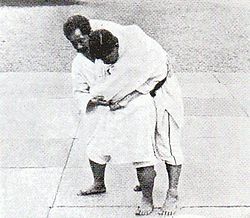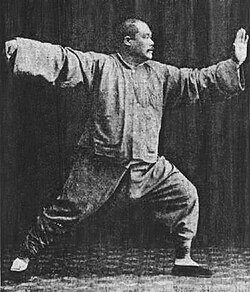Martial arts
| Gather 'round the campfire Folklore |
| Folklore |
| Urban legends |
| Superstition |
Martial arts (also superficially known as kung fu fighting, the art of kicking ass, or dancing in white pyjamas whilst feeling other men's chi) is a common term used to describe formalized systems of fighting. While many people consider martial artists to be badasses who can whup ass, there is a significant amount of woo involved, such as claims of "no touch knock outs" and fat old men who claim to be able to take on 30 d3ad1y n1njers sent to kill them.
The term "martial arts" has become most commonly associated with the various disciplines originating in East Asia, especially systems of armed and unarmed combat such as kung fu, karate and taekwondo. Martial arts is a particularly big money-spinner for the Shaolin Temple in central China. Its monks travel the world putting on a display of their skills, and many tourists visit the monastery itself.
In terms of ritual, sumo wrestling is probably the most intricate martial art of them all. To the untrained eye, a match may look like a pair of alarmingly overweight well-fed men in jock straps shoving each other on a mat, but Japanese sumo fans take the sport ultra-seriously, and being a professional sumo is a life-altering 24/7 commitment, even by professional athlete standards. Even the guy who dresses a sumo wrestler's hair is rigorously trained before he is allowed to practice his craft independently.
However, sports and fighting techniques common in the west, such as boxing, wrestling and fencing are also martial arts. As are rifle shooting, grenade throwing and combat engineers' skills. Basically, anything useful for a soldier is a martial art.
The problem with stylised martial arts[edit]
In terms of combat, the trouble with stylised martial arts in the civilized age is that it has become detached from the harsh feedback of reality. You can learn fighting techniques, but almost no-one doing so is actually having to use their skills in real life on a daily basis. There are endless tales of martial artists of relatively high rank getting their asses handed to them when attacked in the streets because they basically learned a stylised form rather than anything still connected to actual fighting.[1] Note that there are also numerous stories of martial artists beating the snot out of people in fights.
Some of this is because ideas that were meant less as actual techniques, and more as conditioning, are taught as if you'll actually use them in a fight.[2][3] Some prominent martial artists like Bruce Lee have spoken out against stylism in martial arts due to its effect of stagnating self-expression and impeding critical reasoning about what works in a fight.
One interesting counterforce to the woo in martial arts is mixed martial arts, in which the various schools and forms supposedly get tested against each other to various degrees (although there has in the last ten years or so been an emphasis on a specific mixture of Muay Thai, Wrestling, and Brazilian Jiu Jitsu). There appears to be at least some opportunity for bullshit to walk (or not, if it gets its leg broken), but the fight is still highly stylised.
It's worth remembering as well that many people who take up martial arts in modern times aren't looking to learn how to fight or defend themselves, but are looking for some kind of exercise program. Adding to that, martial arts often does come with a philosophy of self-improvement, whether it be growth as a fighter, growth as an athlete or more general personal growth. Often times what you get out of it depends heavily on the quality of your teacher. Furthermore, martial arts, like all arts, is ultimately also a way of expressing yourself.
Bullshido[edit]
The martial arts have inspired all sorts of wootastic claims — termed "bullshido" by some, notably the skeptics community operating at Bullshido.net where the term was coined as a portmanteau of the Japanese martial arts term "Bushido", and of course, "Bullshit". Many make lame attempts to follow concepts they know nothing about, such as taoism, claiming that it gives them all sorts of funky insights. Others make ridiculous claims about chi, stating that it can do such things as give them rapid healing powers, ESP, bulletproofing, or superhuman strength.
Oftentimes, these claims are disproven outright (such as the claims of no-touch knockout). Others are based simply on a misunderstanding of science or using spiritual ideas as a placeholder for science that they don't understand. Many iron hand practitioners think chi is what makes their hand like iron, rather than the progressive microtrauma that causes the bones to grow back thicker, a phenomenon known as Wolff's Law.
A typical claim about martial arts is that they teach you how to "use your opponent's strength against them" and other fancy phrasings like that. Anybody who has actually practiced any martial art will be able to tell you that big strong opponents are a lot tougher than tiny ones, though this claim is most likely what martial arts schools teach to teach someone how to overcome size differences. So really, it's just a fancy phrasing for application of basic physics like reducing the surface area acted upon by a force or outright evasion, withstanding force by distributing it via structure or manipulating momentum via levers. Sometimes movements that are taught aren't even demonstrably applicable anywhere outside of the specific setups used to train them, though practitioners like to think otherwise.
What's a good martial art?[edit]
Art[edit]
Depends what it's for. If you're doing it for the "art" rather than the "martial", most of the highly stylised ones are fine for that. Good exercise, fun, self-discipline, something to do after school, and a sense of achievement. If you master some disciplines you could wind up in the Olympic Games, other disciplines might land you roles in Hollywood/Hong Kong movies.
Note also that nowadays due to a trend of commercialization (taken to extremes in so-called belt factories aka McDojos) it may be difficult to find the right kind of lessons to help you understand the martial art that you are signing up to learn. Very often it does take substantially more than three pounds a lesson, a few gradings on movement routines and a coloured belt to truly learn anything relevant to any of the popular goals people have for practicing.
Fighting[edit]
Be sure to take time to learn some proper self-defence as well if you want that — many martial arts will teach you enough to fight off a bad street fighter, but not a good one (who is also likely to be a borderline nutter). The nature of street fighting is it is difficult or impossible to verify, so bad martial artists may emphasize their ability in respect of street fighting (or secret or obscure competitions) rather than verified recorded accredited competitions of some renown which is much easier to check. Be on your guard for street fighting woo (talk of a "warrior" ethos or "honor" or somesuch): Bruce Lee has, in the past, instructed to bite in videos.[4]
If you want to go out to learn some serious self-defense, join the military. Failing that, Krav Maga has a good reputation, as it was put together by the Israel Defence Force for the specific purpose of fighting off people who want you dead — it benefits from the harsh feedback of reality. Also, it's done in street clothes — if you normally wear a PVC catsuit and high heels, that's what you train in. It also teaches its students the only way to go about disarming an assailant with a gun: Don't ever fucking try it.
Krav McGa[edit]
Sadly, there's quite a lot of rubbish taught as "Krav Maga" which has little to do with the learn-this-or-die stuff taught in the IDF, and Krav can occasionally devolve into "100 ways to rip someone's testicles off", and since there is very little in the way of competitive Krav Maga it is difficult to assess whether an individual dojo is any good or is just "2lethal4thering".[5] This is an unfortunate byproduct of Krav Maga's growth in popularity: Krav's still-good reputation gives charlatans a good opportunity to separate insecure Walter Mitty-types from their money.
Mixed Martial Arts[edit]
While various sports comparable to MMA have existed on and off since the dawn of time, the first UFC Pay-Per-View did more to dispel people's misconceptions about martial arts than any other event in world history.[6][7][8] Originally starting off as an infomercial for Gracie Jiu Jitsu, most average Americans ordering the show had no idea that while kicks and punches looked cool, they were useless in the face of grappling moves.
There are still many misconceptions on MMA and martial arts in general that persist to this day, and since mastering martial arts takes significantly more work than just dancing around in your underwear, this'll likely always be the case. No matter what, the sport's rise to the popular consciousness is a victory for reason that's reached millions of minds.
Over the history of MMA, the most popular combination of styles that have emerged dominant typically involve Brazilian Jiu-jitsu, Thai/Western/"Dirty" Boxing, and Wrestling. There is not a single elite MMA fighter who isn't world class in at least one of those disciplines, and with the exception of the very early days in MMA, all elite MMA fighters are at least pretty good in all of those disciplines.
The reason for this breadth is straightforward. Pure striking arts are essentially helpless when rules allow grappling and if the rules allow kicks, you need to be able to do and defend those. Woo, rigid "form" arts and street brawling were weeded out in the early going.
Brazilian Jiu-jitsu is extremely popular and probably the most successful in MMA because it allows for beginner friendly, frequent and (relative) low-risk full contact training because there is no striking and less focus on takedowns than in wrestling. The minimum required athleticism to be proficient at BJJ is also extremely low. It also enjoyed early success because defending and preventing many submission holds in BJJ is not very intuitive if you are not familiar with submission grappling styles. For someone completely unfamiliar with martial arts but wishing to learn how to fight, BJJ would generally be the best starting point. A final upside is that because BJJ is a young sport, and the lineage of all Black Belts is pretty well known and Black Belts are extremely difficult to earn, typically 12-20 years, it's prohibitive and risky for most con artists to lie about their BJJ credentials, lest they be discovered by people actually ranked in BJJ a la James Paredes. However, even in the BJJ world, frauds do exist.
See also[edit]
External links[edit]
- Bullshido - The Art of Fighting BS
- Hiyaa Podcast. A sort of skeptic martial arts podcast.
References[edit]
- ↑ http://www.survivopedia.com/martial-arts-myths-debunked/
- ↑ Several well respected martial artists have written articles hypothesizing that techniques like "jumping" or "flying" kicks were meant to train the legs, not to be actually used.[citation needed]
- ↑ Martial Street Art: Push Hands: Introduction - gives a good idea of how forms and routines are said to be helpful, supposedly even for combat training.
- ↑ [1], Jeet Kune Do Lessons | Bite When You Are In A Headlock (Youtube) .
- ↑ e.g. [2]
- ↑ http://fightland.vice.com/blog/a-look-back-at-ufc-1---part-1
- ↑ http://fightland.vice.com/blog/a-look-back-at-ufc-1---part-2
- ↑ http://www.bloodyelbow.com/2012/3/26/2890710/mma-origins-ufc-1-MMA-History





